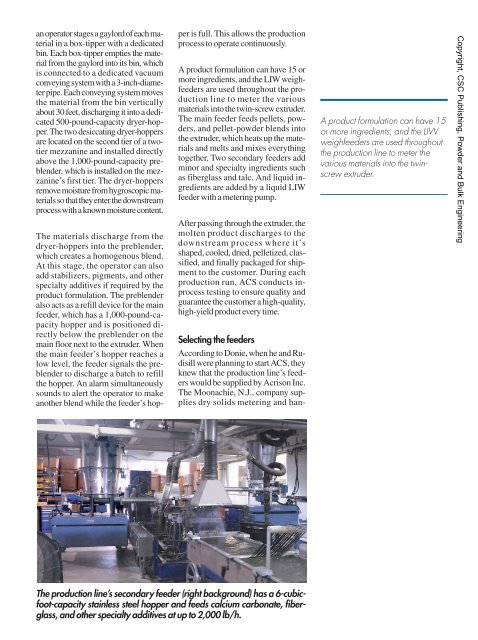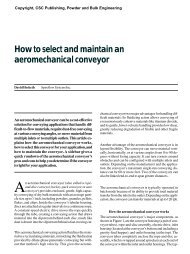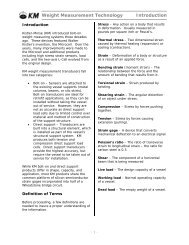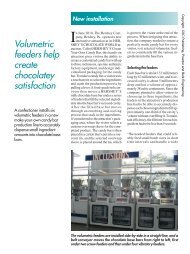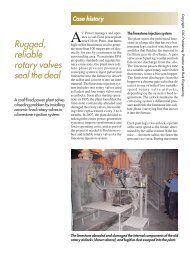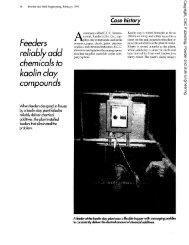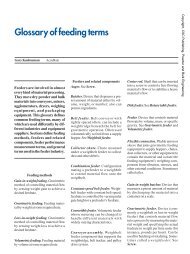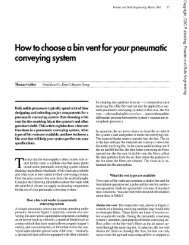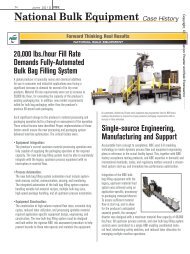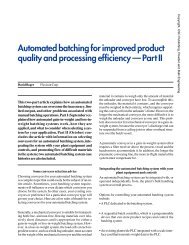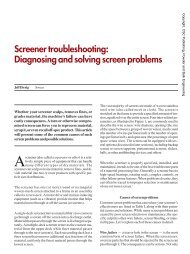Acrison - Powder and Bulk Engineering Magazine
Acrison - Powder and Bulk Engineering Magazine
Acrison - Powder and Bulk Engineering Magazine
Create successful ePaper yourself
Turn your PDF publications into a flip-book with our unique Google optimized e-Paper software.
an operator stages a gaylord of each material<br />
in a box-tipper with a dedicated<br />
bin. Each box-tipper empties the material<br />
from the gaylord into its bin, which<br />
is connected to a dedicated vacuum<br />
conveying system with a 3-inch-diameter<br />
pipe. Each conveying system moves<br />
the material from the bin vertically<br />
about 30 feet, discharging it into a dedicated<br />
500-pound-capacity dryer-hopper.<br />
The two desiccating dryer-hoppers<br />
are located on the second tier of a twotier<br />
mezzanine <strong>and</strong> installed directly<br />
above the 1,000-pound-capacity preblender,<br />
which is installed on the mezzanine’s<br />
first tier. The dryer-hoppers<br />
remove moisture from hygroscopic materials<br />
so that they enter the downstream<br />
process with a known moisture content.<br />
The materials discharge from the<br />
dryer-hoppers into the preblender,<br />
which creates a homogenous blend.<br />
At this stage, the operator can also<br />
add stabilizers, pigments, <strong>and</strong> other<br />
specialty additives if required by the<br />
product formulation. The preblender<br />
also acts as a refill device for the main<br />
feeder, which has a 1,000-pound-capacity<br />
hopper <strong>and</strong> is positioned directly<br />
below the preblender on the<br />
main floor next to the extruder. When<br />
the main feeder’s hopper reaches a<br />
low level, the feeder signals the preblender<br />
to discharge a batch to refill<br />
the hopper. An alarm simultaneously<br />
sounds to alert the operator to make<br />
another blend while the feeder’s hopper<br />
is full. This allows the production<br />
process to operate continuously.<br />
A product formulation can have 15 or<br />
more ingredients, <strong>and</strong> the LIW weighfeeders<br />
are used throughout the production<br />
line to meter the various<br />
materials into the twin-screw extruder.<br />
The main feeder feeds pellets, powders,<br />
<strong>and</strong> pellet-powder blends into<br />
the extruder, which heats up the materials<br />
<strong>and</strong> melts <strong>and</strong> mixes everything<br />
together. Two secondary feeders add<br />
minor <strong>and</strong> specialty ingredients such<br />
as fiberglass <strong>and</strong> talc. And liquid ingredients<br />
are added by a liquid LIW<br />
feeder with a metering pump.<br />
After passing through the extruder, the<br />
molten product discharges to the<br />
downstream process where it’s<br />
shaped, cooled, dried, pelletized, classified,<br />
<strong>and</strong> finally packaged for shipment<br />
to the customer. During each<br />
production run, ACS conducts inprocess<br />
testing to ensure quality <strong>and</strong><br />
guarantee the customer a high-quality,<br />
high-yield product every time.<br />
Selecting the feeders<br />
According to Donie, when he <strong>and</strong> Rudisill<br />
were planning to start ACS, they<br />
knew that the production line’s feeders<br />
would be supplied by <strong>Acrison</strong> Inc.<br />
The Moonachie, N.J., company supplies<br />
dry solids metering <strong>and</strong> han-<br />
A product formulation can have 15<br />
or more ingredients, <strong>and</strong> the LIW<br />
weighfeeders are used throughout<br />
the production line to meter the<br />
various materials into the twinscrew<br />
extruder.<br />
Copyright, CSC Publishing, <strong>Powder</strong> <strong>and</strong> <strong>Bulk</strong> <strong>Engineering</strong><br />
The production line’s secondary feeder (right background) has a 6-cubicfoot-capacity<br />
stainless steel hopper <strong>and</strong> feeds calcium carbonate, fiberglass,<br />
<strong>and</strong> other specialty additives at up to 2,000 lb/h.


